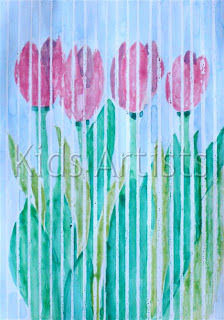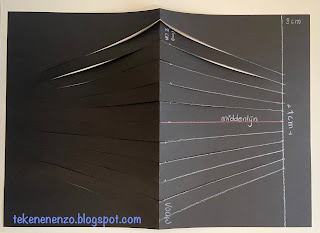- drawing sheet
- tempera paint in red and white
- crayons
- liquid water color paint
- brush
- broccoli
zaterdag 15 april 2023
Cherry blossom tree
donderdag 13 april 2023
Tulips; spring is coming!
- a bunch of tulips
- vases or glasses
- drawing paper A4 size
- white crayons
- water paint
- brushes
- jar with water
- colored paper for background
- glue
Painting without using your hands
You need:
- big drawing sheets
- brushes
- tempera paint
- liquid water color paint
- tape
Painting without using your hands is quite a challenge! You can paint with your feet or mouth. We tried both.
Painting with your feet
Put tables aside, newspapers on the floor and stick drawing sheets on top. Very important: take off the shoes in the hallway and leave them there 😀
Place a container with three colors tempera paint between two students. A beautiful portrait is too much, so ask them to paint simple lines or shapes.
Painting with your mouth
This is less difficult. Cover the tables with newspapers. Place jars with diluted water color paint and brushes. Students may paint what the want. You may also give them a simple goal: paint rectangles in different colors.
dinsdag 11 april 2023
Japanese cherry blossom on a plate
You need:
- paper plates
- acrylic paint: brown, green, red, white
- brush
- crepe paper: pink, white, red
- glue
vrijdag 31 maart 2023
April showers will bring us flowers
- white drawing sheet
- water colour paint
- ruler
- white crayon or oil pastel
- paint brush
- water
Sketch some spring flowers on a white sheet. Make sure your lines are extremely thin. Use your ruler to draw white crayon lines with one centimeter between them. Make sure your crayon has a sharp point. Paint your drawing with watercolour paint. Use a lot of water to make bright colours. The crayon will resist the water paint, so your shower will be very clear!
donderdag 30 maart 2023
Like Romero Britto
What do you need?
- white drawing sheet
- permanent marker
- colour markers
- ruler
- bright colours
- simple shapes
- the work is divided into sections that are filled with patterns
- thick black outlines
What should you do?
- Draw a picture of a subject of your choice - no details, just the main lines.
- Divide the drawing sheet with pencil and ruler in several sections.
- Trace all lines with a waterproof black marker.
- Color the whole sheet with markers like Britto did.
Op art around an eye
You need:
- drawing sheet 20 by 20 cm
- ruler
- pencil
- post it
- black markers
woensdag 29 maart 2023
Animals in spring like Hans Innemee
- grey construction paper 21 bij 21 cm
- oilpastels
dinsdag 28 maart 2023
Athletes in motion
You need:
- colored construction paper
- white drawing sheet
- paperclips
- scissors
- cutting mat and cutting knife
- glue
- marker
- photo of an athlete
zondag 5 februari 2023
Art Noveau tiles
- colored paper 10 by 10 cm
- linoleum 10 by 10 cm
- colored cardboard karton 25 bij 25 cm
- carbon paper
- lino knife
- flat piece of glass
- block printing ink
- lino roller
- lino press
- glue
Art Noveau was mainly applied to everyday products (for emample furniture, glassware, jewellery), in architecture, graphic art and painting. Artists were inspired by nature: patterns with birds, flowers, plants. clouds, rocks, women. Graceful moving lines express emotion.
Show Art Noveau tiles: with 2 mirror lines or tiles that form a tableau in a group of 4.
vrijdag 3 februari 2023
Self portrait like Alphonse Mucha
- portrait photo of yourself
- white drawing sheet
- brown and grey construction paper
- color pencil
- gold pencil
- scissors
- glue
Task
Draw the picture of yourself and color it with pencils. Cut out and stick on brown paper. Decorate the background with organic shapes using a gold color pencil. Cut a frame for you portrait and stick it on your artwork.
donderdag 2 februari 2023
Art Nouveau flower tiles
Art Nouveau or Jugendstil is an art style that was practiced from 1890 and abruptly stopped with the start of World War 1 in 1914. t die werd beoefend vanaf circa 1890 en abrupt stopte met de start van WO1 in 1914.
Art Noveau was mainly applied to everyday products (for emample furniture, glassware, jewellery), in architecture, graphic art and painting. Artists were inspired by nature: patterns with birds, flowers, plants. clouds, rocks, women. Graceful moving lines express emotion.
Famous Art Nouveau artists are Alphonse Mucha, Gustav Klimt, Gaudi, Berlage.
You need:
- folding sheets 10 by 10 cm in several colors
- pencil
- scissors
- glue
- colored construction paper 30 by 20 cm
Show pictures of Art Nouveau tiles: organic shapes of flowers and plants.
Tell students they are going to build a litte wall of tiles in Art Nouveau style. Every wall has six tiles. Flowers have to be cut out of the folding sheets. Try to use as much as possible of those sheets, so what you cut you glue on the wall.
Artworks made by students of grade 2
woensdag 1 februari 2023
Op art paper weaving like Victor Vasarely
Victor Vasarely, 1906-1997, was a French-Hungarian artist and one of the most important representives of Op Art. Vasarely studied in Budapest and left for Paris in 1930 to work as a decorator.
Op-art, short for optical art. The word optical is used to describe tings that relate to how we see. Artists use shapes, colours and patterns in special ways to create images that look as if they are moving or blurring. Op art started in the 1960. Op-art is a style of visual art that uses optical illusions. The artwork gives the viewer the impression of movement, hidden images and vibrating patterns.
You need:
- black construction sheet (23 by 33 cm,)
- white or colored paper in strips of 2 cm
- ruler
- pencil
- scissors
- glue
Stap 2
Leave the sheet folded in half. Cut the lines up to the 3 cm strip.
Weave the strips into the frame. Start in the middle: press the strips agaiinst the fold on both sides. Press the next strips against the previous ones. Stap 4
Glue the loose ends on one site.
Stap 5




.jpg)








.jpg)







































